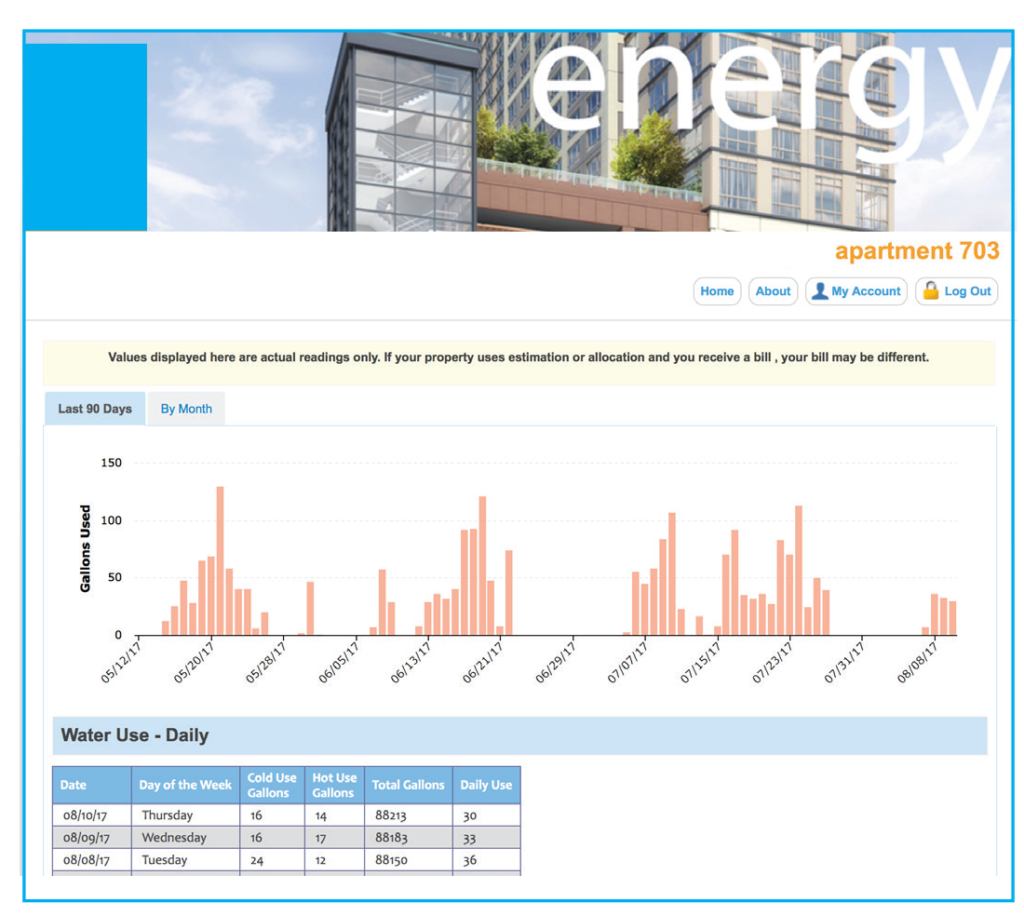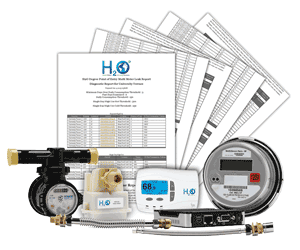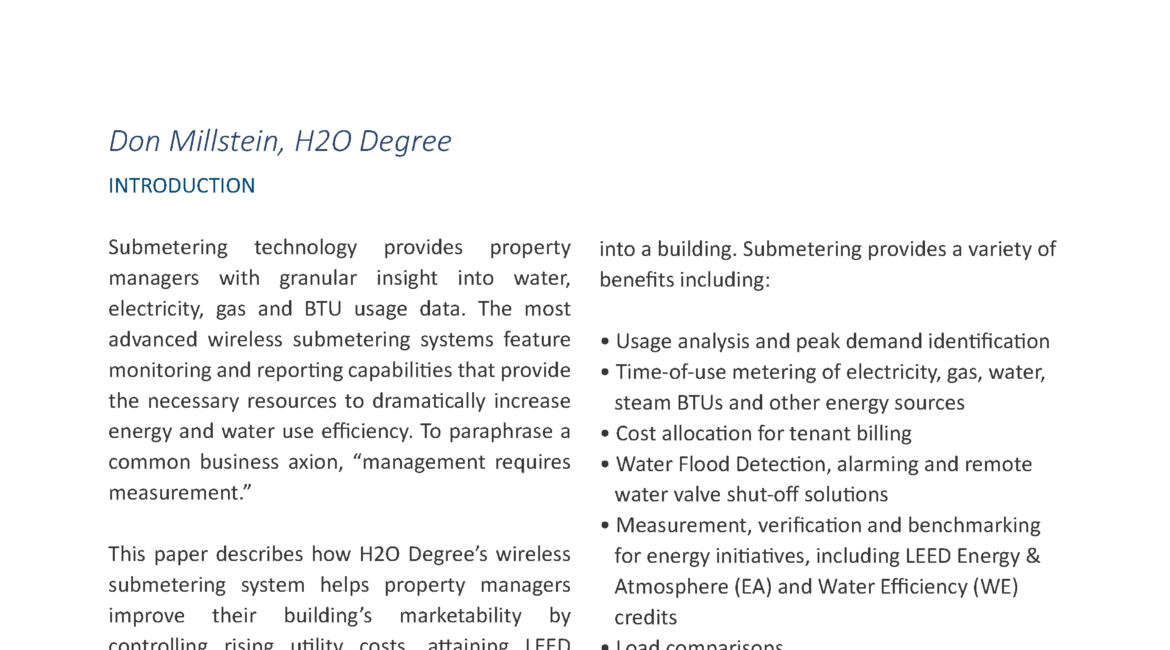
Submetering Systems give Property Managers a Effective Utility Management Tool
By Don Millstein, H2O Degree
INTRODUCTION
What is Submetering?
- Cost allocation for tenant billing
- Water leak detection based on daily reports enable maintenance staff to take proactive measures and avoid significant, and costly water loss
- Usage analysis and peak demand identification
- Water flood detection, alarming and remote water valve shut-off solutions
- Measurement, verification and benchmarking for energy initiatives, including LEED Energy & Atmosphere (EA) and Water Efficiency (WE) credits
- Time-of-use metering of electricity, gas, water, steam BTUs and other energy sources
- Load comparisons
- Threshold alarming & notification
- Multi-site load aggregation and real time historical monitoring of energy consumption patterns for negotiating lower energy rates, etc.

ENERGY SAVINGS

Wireless Metering Technology
 Since the introduction to the market in the early 1980s, submeters have evolved in terms of functionality and usefulness. Today’s most advanced submeters combine wireless technologies and cloud-based monitoring to enable:
Since the introduction to the market in the early 1980s, submeters have evolved in terms of functionality and usefulness. Today’s most advanced submeters combine wireless technologies and cloud-based monitoring to enable:- Two-way wireless mesh submetering of utilities (water, electric, gas, BTUs)
- Water leak detection and alarming
- Wireless thermostat control
- Utility consumption analysis and reporting


Building owners and managers of multi-family and commercial buildings are increasingly turning to sophisticated submetering systems that provide tenant billing, leak detection, utility conservation and building automation system integration. Typical submetering applications average a one-year payback period and water leak detection/thermostat control applications typically see a 2-3 year payback period, however inefficient buildings may see payback in under a year. Benefits for building owners and management include:
- Achieve maximum energy efficiency
- Reduce operating expenses
- Creating management and tenant behavior change
- Increase Net Operating Income (NOI)
- Improve property valuation
 Access to Actionable Data
Access to Actionable Data
The H2O Degree wireless submetering system provides insight into utility usage data by utilizing the company’s cloud-based platform for reporting, billing and analysis. The system integrates easily with leading third-party RBC (Read, Bill, Collect) service providers to streamline the process of billing tenants for their utility consumption. Property managers gain actionable insight into the buildings water consumption with daily leak reporting and instantaneous water leak alarms determined by a variety of available water flood detection devices.
For their part, property managers with access to precise water consumption data can quickly locate and repair leaking toilets, which represents almost 70% of the water wasted in a multi-family building. In this scenario, managers receive daily water “leak reports” based on granular data collected by H2O Degree’s battery-operated wireless water meters installed throughout the building. With visibility into increased “events” (i.e. toilet flushes), managers can drill down to the specific location and source of the problem — such as a broken flapper valve or cracked fill valve — and direct maintenance staff to repair the problem before significant amounts of water is wasted.
 Benefits for Tenants
Benefits for Tenants
Tenants, for their part, are encouraged to conserve since they are accountable for their own, individual energy and water use. H2O Degree’s wireless submetering system offers a web portal where tenants can view their own consumption — which encourages them to take steps to reduce their future utility bills. They can also use a mobile app to adjust thermostat temperature and set-points to save costs on heating and cooling.

LEED Certification and Water Efficiency Mandates
Analysis of historical metering reports can lead to additional conservation opportunities that can improve property values. By reducing water and energy consumption, the wireless submetering system can help building managers earn valuable points towards LEED, the international standard that incentivizes environmental building practices.
LEED v4 is the highest level of certification, the EA and WE credit areas specify which points require submeters and other data collection devices including:
• Building-Level Energy Metering
• Advanced Energy Metering
• Demand Response (DR)
• Water Metering
• Building-Level Water Metering
With their advanced functionality in monitoring and reporting water usage, H2O Degree’s water submeters are becoming essential for fulfilling the requirements of the Water Efficiency (WE) category under LEED v4.
LEED Credit Information Home Design & Construction | H2O Degree Products Utilized |
|---|---|
WE Prerequisite: Water Efficiency | Water Meters, Leak Detection Reports & Usage Reports |
WE Credit: Total Water Use | Water Meters, Leak Detection Reports & Usage Reports |
EA Prerequisite: Minimum Energy Performance | Water, Electric, Gas & BTU Meters, Leak Detection & Usage Reports |
EA Prerequisite: Energy Metering | Water, Electric, Gas & BTU Meters, Usage Reports |
EA Credit: Annual Energy Use | Water, Electric, Gas & BTU Meters, Leak Detection & Usage Reports |
EA Credit: Advanced Utility Tracking | Water, Electric, Gas & BTU Meters, Leak Detection & Usage Reports |
EA Credit: Space Heating & Cooling Equipment | Thermostats & Usage/Validation Reports |
EA Credit: Domestic Hot Water Equipment | Water Meters, Leak Detection Reports & Usage/Validation Reports |
EQ Credit: Balancing of Heating & Cooling Dist. | Thermostats & Water Meters |
Existing Buildings: Building Operations & Maintenance and Building Design & Construction | H2O Degree Products Utilized |
|---|---|
WE Prerequisite: Indoor Water Use Reduction | Water Meters, Leak Detection Reports & Usage/Validation Reports |
WE Prerequisite: Buiding-Level Water Metering | Water Meters, Leak Detection Reports & Usage/Validation Reports |
WE Credit: Outdoor Water Use Reduction | Water Meters, Leak Detection Reports & Usage/Validation Reports |
WE Credit: Indoor Water Use Reduction | Water Meters, Leak Detection Reports & Usage/Validation Reports |
WE Credit: Water Metering | Water Meters, Leak Detection Reports & Usage/Validation Reports |
EA Prerequisite: Energy Efficient Best Practices | Water Meters, Thermostats, Leak Detection & Utility/Validation Reports |
EA Prerequisite: Minimum Energy Performance | Water, Electric, Gas & BTU Meters, Leak Detection & Usage/Validation Reports |
EA Prerequisite: Building-Level Energy Metering | Water, Electric, Gas & BTU Meters, Leak Detection & Usage/Validation Reports |
EA Credit: Existing Buildings Commissioning-Analysis | Water, Electric, Gas & BTU Meters, Leak Detection & Usage/Validation Reports |
EA Credit: Existing Building Comm.-Implementation | Leak Detection & Usage/Validation Reports |
EA Credit: Ongoing Commissioning | Leak Detection & Usage/Validation Reports |
EA Credit: Optimize Energy Performance | Usage/Validation Reporting |
EA Credit: Advanced Energy Metering | Water, Electric, Gas & BTU Meters, Leak Detection & Usage/Validation Reports |
EA Credit: Demand Response | Water, Electric, Gas & BTU Meters, Leak Detection & Usage/Validation Reports |
EQ Credit: Thermal Comfort | Thermostats, Usage/Validation Reporting |
** This list is subject to change without notice. Visit www.usgbc.org for complete details and LEED credit requirements for your particular application.

California’s SB7 Submetering Mandate
H2O Degree’s wireless submetering system provides the perfect solution for property managers in California who need to comply with SB7. California SB7 is the landmark law that mandates water meters and submeters be installed in all new apartment and other multi-family residential buildings constructed after January 1, 2018.
Owners and managers of these rental properties must provide residents with accurate information about volume and cost of their water usage through their own individual submeters. The law also requires resident billing for water based on actual usage rather than by estimation or other methodology.
Even in states that do not mandate water conservation, H2O Degree’s water submetering system is a smart water conservation investment. The system’s water leak reporting feature can lead to a reduction in a building’s average daily consumption (ADC) by as much as 50 percent.
Submetering Results
The H2O Degree wireless submetering system offers property managers a more precise approach to monitoring utility consumption and allocating costs in multi-family and commercial buildings.
Access to real-time submetering data allows owners to bill tenants more accurately, and analyzing water leak reports helps them identify and fix problems proactively. They can encourage tenants to use less energy and water by viewing individualized usage online, and incentivize them to conserve.
By utilizing H2O Degree submetering and water leak detection systems, property owners & managers now have access to cost effective tools that support energy conservation and cost reduction, while supporting conservation programs such as LEED and also comply with energy mandates such as SB7.
H2O Degree systems have been the chosen tool for energy management for 25+ years. To learn more about H2O Degree systems, or to request a free site survey contact our submetering experts at info@h2odegree.com.
ABOUT H2O DEGREE
H2O Degree manufactures a broad line of wireless, radio-based submetering and leak detection systems that measure individual apartment or condo use of water, domestic hot water energy, boiler and chiller energy, electricity, gas and BTUs. The company also offers Green Thermostats, which track energy use and apartment temperature while allowing tenants and property owners to set temperature set-points and schedules, adjust set-back temperatures when tenants are away or asleep and report HVAC maintenance issues. For more information, please go to: www.h2odegree.com.

